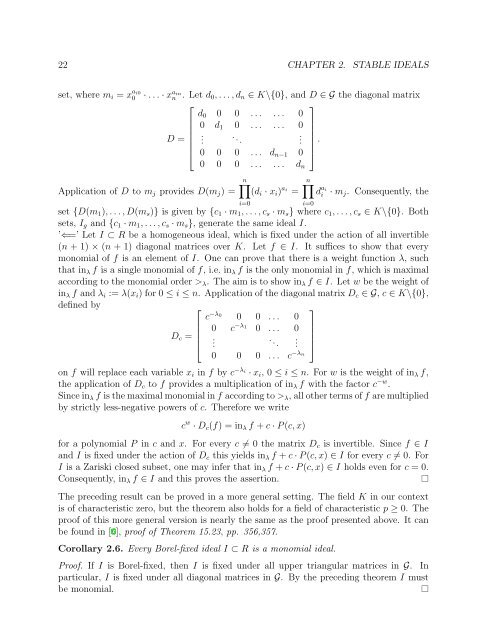University of Paderborn Department of Mathematics Diploma Thesis ...
University of Paderborn Department of Mathematics Diploma Thesis ...
University of Paderborn Department of Mathematics Diploma Thesis ...
You also want an ePaper? Increase the reach of your titles
YUMPU automatically turns print PDFs into web optimized ePapers that Google loves.
22 CHAPTER 2. STABLE IDEALSset, where m i = x a i00 · . . . · x a inn . Let d 0 , . . . , d n ∈ K\{0}, and D ∈ G the diagonal matrix⎡⎤d 0 0 0 . . . . . . 00 d 1 0 . . . . . . 0D =⎢... . ..⎥⎣ 0 0 0 . . . d n−1 0 ⎦0 0 0 . . . . . . d nApplication <strong>of</strong> D to m j provides D(m j ) =n∏(d i · x i ) a i=i=0n∏i=0d a ii· m j . Consequently, theset {D(m 1 ), . . . , D(m s )} is given by {c 1 · m 1 , . . . , c s · m s } where c 1 , . . . , c s ∈ K\{0}. Bothsets, I g and {c 1 · m 1 , . . . , c s · m s }, generate the same ideal I.’⇐=’ Let I ⊂ R be a homogeneous ideal, which is fixed under the action <strong>of</strong> all invertible(n + 1) × (n + 1) diagonal matrices over K. Let f ∈ I. It suffices to show that everymonomial <strong>of</strong> f is an element <strong>of</strong> I. One can prove that there is a weight function λ, suchthat in λ f is a single monomial <strong>of</strong> f, i.e. in λ f is the only monomial in f, which is maximalaccording to the monomial order > λ . The aim is to show in λ f ∈ I. Let w be the weight <strong>of</strong>in λ f and λ i := λ(x i ) for 0 ≤ i ≤ n. Application <strong>of</strong> the diagonal matrix D c ∈ G, c ∈ K\{0},defined by⎡⎤c −λ 00 0 . . . 00 c −λ 10 . . . 0D c = ⎢⎣....⎥ . ⎦0 0 0 . . . c −λnon f will replace each variable x i in f by c −λi · x i , 0 ≤ i ≤ n. For w is the weight <strong>of</strong> in λ f,the application <strong>of</strong> D c to f provides a multiplication <strong>of</strong> in λ f with the factor c −w .Since in λ f is the maximal monomial in f according to > λ , all other terms <strong>of</strong> f are multipliedby strictly less-negative powers <strong>of</strong> c. Therefore we writec w · D c (f) = in λ f + c · P (c, x)for a polynomial P in c and x. For every c ≠ 0 the matrix D c is invertible. Since f ∈ Iand I is fixed under the action <strong>of</strong> D c this yields in λ f + c · P (c, x) ∈ I for every c ≠ 0. ForI is a Zariski closed subset, one may infer that in λ f + c · P (c, x) ∈ I holds even for c = 0.Consequently, in λ f ∈ I and this proves the assertion.The preceding result can be proved in a more general setting. The field K in our contextis <strong>of</strong> characteristic zero, but the theorem also holds for a field <strong>of</strong> characteristic p ≥ 0. Thepro<strong>of</strong> <strong>of</strong> this more general version is nearly the same as the pro<strong>of</strong> presented above. It canbe found in [6], pro<strong>of</strong> <strong>of</strong> Theorem 15.23, pp. 356,357.Corollary 2.6. Every Borel-fixed ideal I ⊂ R is a monomial ideal.Pro<strong>of</strong>. If I is Borel-fixed, then I is fixed under all upper triangular matrices in G. Inparticular, I is fixed under all diagonal matrices in G. By the preceding theorem I mustbe monomial.
















